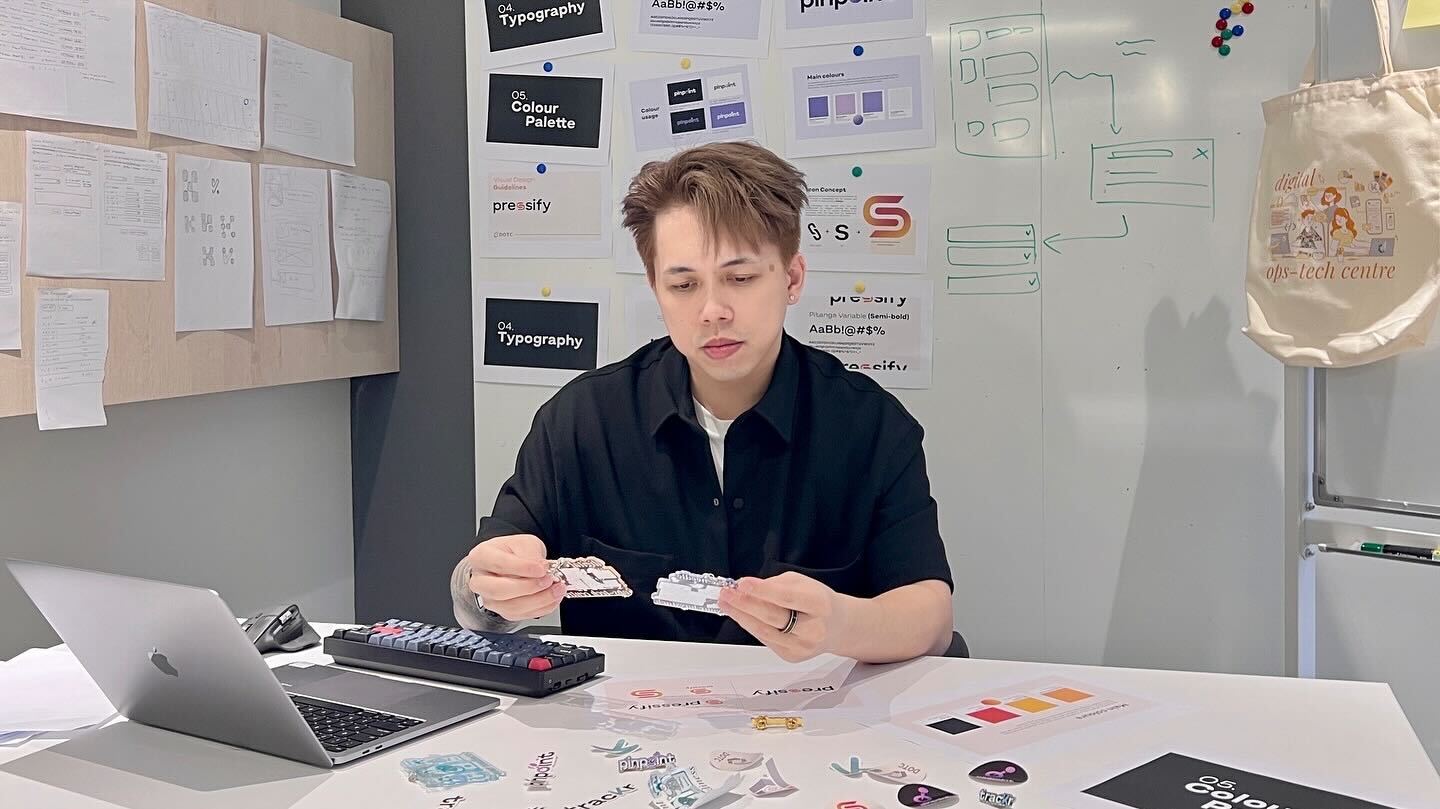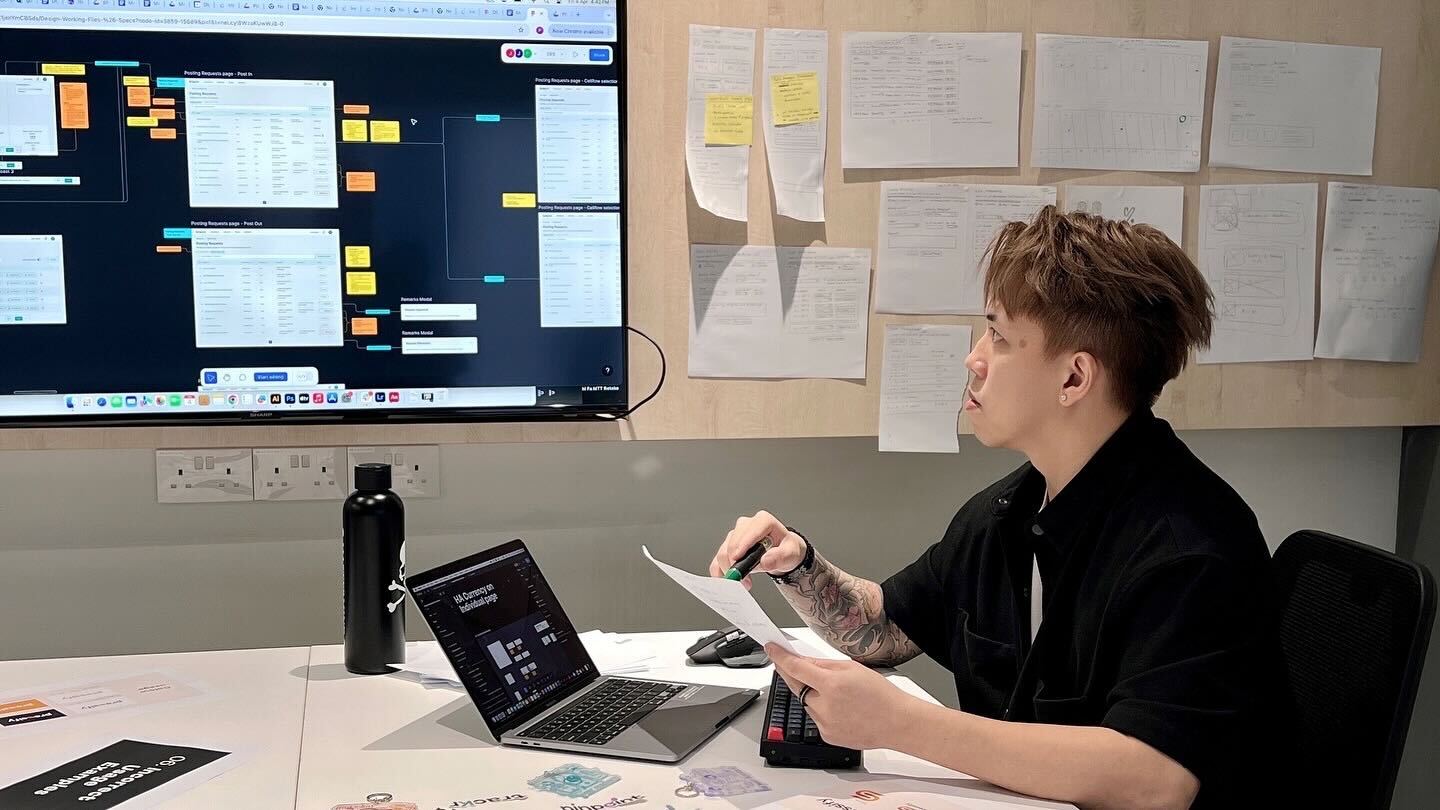Inside DOTC Series: Crafting Meaningful Experiences Through Design

At DOTC, design is more than just aesthetics — it’s about crafting experiences that are seamless, functional, and impactful. Our Product Design team is dedicated to making every interaction intuitive and meaningful, ensuring that innovation is always paired with real-world usability.
To gain deeper insight into the world of product design, we spoke with Joel Tai, a Senior Product Designer and the marketing lead for this series. Joel shared his journey in the field, his passion for solving complex problems, and what drives his creative process. Outside of work, he wears multiple hats — serving as a volleyball club representative for Taman Jurong CSN and embracing life as a proud cat parent to two beloved feline companions.
How do you turn an idea into a great design?
"Turning an idea into a great design is a blend of structured creativity, strategic thinking, and iterative problem-solving. It all starts with deeply understanding the problem space—not just at a surface level, but by immersing myself in the user’s world. This means engaging with stakeholders, conducting research, and mapping out user pain points to uncover both explicit and latent needs.
From there, I translate insights into early concepts, sketching rough ideas to explore different solutions. Rapid prototyping follows, allowing me to test assumptions, identify friction points, and refine interactions in a tangible way. I believe great design isn’t created in isolation—it's shaped by continuous feedback loops, real-world validation, and collaboration with cross-functional teams.
A mediocre idea becomes a great design when it strikes the right balance between usability, feasibility, and impact. It’s not just about making something visually appealing—it’s about ensuring the design is intuitive, efficient, and meaningful for the people who use it."

Which is harder: choosing the perfect font or agreeing on a colour palette?
"Colours trigger immediate emotional reactions, but typography quietly shapes how we experience content. A colour palette can set the tone—warm and inviting, cold and authoritative, or somewhere in between—but typography dictates how information flows and how effortlessly it is consumed.
That’s why the hardest choice is often the one that goes unnoticed—the one that ‘just feels right.’ A perfect font seamlessly guides the reader, while a well-balanced colour palette subtly reinforces brand identity and usability. Both require deep consideration, but if I had to choose, I’d say typography is trickier. A single typeface affects readability, hierarchy, and even perception of trust, making it a decision that demands both logic and intuition.
At the end of the day, the real challenge isn’t picking a font or a colour—it’s ensuring they work harmoniously to create a cohesive and intuitive experience."

What is the overarching goal you want your design to achieve in terms of its effect on people?
"A great design should empower people by removing friction and enabling them to focus on what truly matters. Whether it’s a mission-critical system, an operational dashboard, or a simple digital interface, design should work so seamlessly that it almost becomes invisible.
For me, the goal is to create experiences that feel intuitive, reliable, and effortless. Users shouldn’t have to wrestle with the interface; instead, it should anticipate their needs, guide them naturally, and instill confidence in their actions. A well-designed product doesn’t just solve problems—it enhances efficiency, reduces cognitive load, and, at its best, improves the way people work and interact with technology.
At the end of the day, great design isn’t just about aesthetics or functionality—it’s about creating a sense of trust, clarity, and empowerment in every interaction."

What’s your favourite part of the design process: brainstorming ideas, prototyping, or perfecting the final design?
"Prototyping is my favourite part of the design process because that’s where ideas truly come to life. It’s the stage where abstract concepts turn into something tangible—something that users can interact with, test, and respond to.
I love the problem-solving aspect of it: seeing what works, what falls flat, and what surprises me. Prototyping allows for rapid iteration, helping me validate assumptions, refine interactions, and uncover insights that wouldn’t be obvious on paper. It’s where design shifts from theory to reality, and where the most meaningful improvements happen.
That said, brainstorming sparks creativity, and perfecting the final design brings satisfaction, but prototyping is where you separate good ideas from great ones—and that’s what makes it the most exciting part for me."
Based on your experience at DOTC so far, what has been the most memorable moment for you?
"One of my most memorable moments at DOTC was organising our first Product Design talk, where I had the opportunity to share insights on how familiar design principles evolve to meet the critical demands of operationally-driven projects with the Singapore Product Design community.
I walked the audience through the key differences and surprising similarities between commercial and military UX, highlighting the challenges of designing for high-stakes environments where reliability, security, and user efficiency are paramount.
One of the highlights was engaging with new designers entering the field, who found value in understanding how we navigate the complexities of military UX. It was also a great opportunity to connect with fellow designers from CSIT and DSTA, exchanging ideas on the evolving role of UX in national defence. Seeing the enthusiasm and curiosity from the community reaffirmed the importance of fostering design conversations beyond our immediate domain and how crucial it is to share, learn, and grow as a design community."
I understand that you’ll be competing in the Volleyball Masters Tournament in Taiwan this May. From your experience, how has the fast-paced nature of volleyball influenced your design process, especially when working under pressure?
"Volleyball and design both demand adaptability, quick thinking, and trust in your team. In a fast-paced game, you can’t predict every play, but you train your instincts to read the situation, make split-second decisions, and adjust on the fly. The same applies to design—especially under pressure.
In high-stakes projects, deadlines shift, priorities change, and unexpected challenges arise. Just like in volleyball, you need to stay agile, react strategically, and rely on your team’s strengths. You learn to embrace fast iterations, communicate effectively, and maintain composure even when the stakes are high.
At the end of the day, both volleyball and design require a balance of skill, intuition, and teamwork. You don’t just react—you anticipate, adapt, and execute with confidence."
Joel’s journey at DOTC is a testament to the intersection of creativity, strategy, and adaptability that drives product design. Whether refining user experiences, leading community conversations, or drawing inspiration from volleyball, he brings a dynamic approach to design that ensures innovation meets real-world impact.
Interested in shaping the future with us? Join DOTC and be part of the change!

